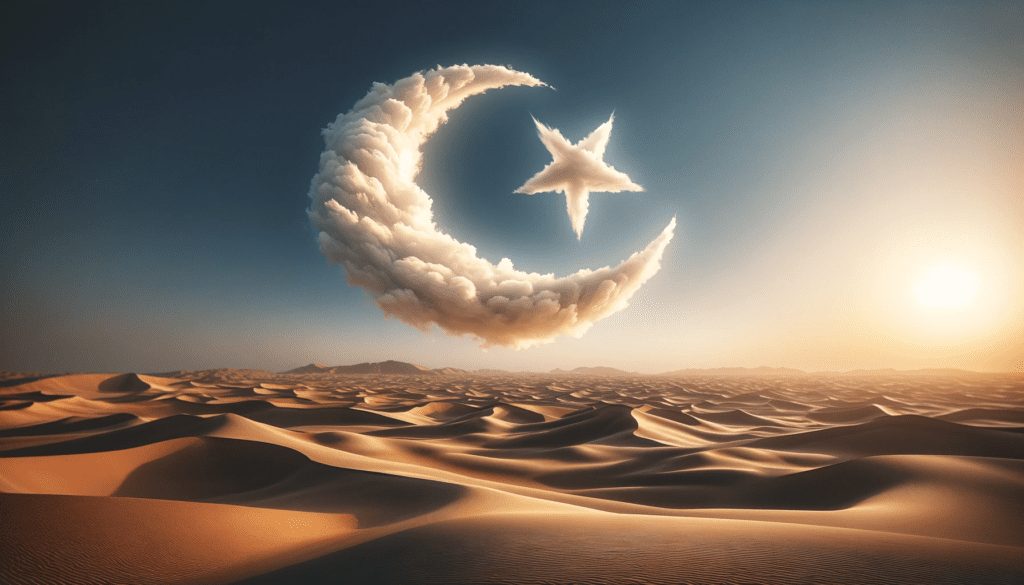Eid al Fitr is also know under the following Terms: Feast of Breaking the Fast, the Sugar Feast, Bayram (Bajram), the Sweet Festival and the Lesser Eid. The religious holiday is celebrated by Muslims around the world and marks the end of Ramadan, the Islamic holy month of fasting (sawm).
Dates for -Eid al Fitr
- Eid-al-Fitr in 2025 will be around 31th of March 2025 (or evening 30 of March)
- Eid-al-Fitr in 2024 was around 9th of April 2024 (or evening 8th of April)
The holiday varies on the Gegorian calender, which is a solar calender, while it is fixed in the Islamic Calender, which is lunar based. Ed al Fitr may fary from Timezone to Timezone, as it is depending on the sighting of the moon.

Eid al-Fitr, also known as the “Festival of Breaking the Fast,” is one of the most significant Islamic holidays celebrated worldwide. It marks the end of Ramadan, a month of fasting and spiritual reflection. While there may be some variations in traditions and customs depending on the country and region, there are several common practices observed in Muslim countries during Eid al-Fitr:
- Special Prayers: The day begins with a special Eid prayer known as the “Eid Salah” or “Eid Namaz.” Muslims gather at mosques or open prayer grounds to perform these prayers. It is a time for spiritual reflection, gratitude, and community bonding.
- Eid Greetings: People exchange greetings and good wishes. Common greetings include “Eid Mubarak” which means “Blessed Eid” and “Eid Sa’id” which means “Happy Eid.”
- New Clothes: Many people, especially children, wear new or their finest clothes on this day. It is a tradition to dress in one’s best attire to mark the festive occasion.
- Giving Zakat al-Fitr: Before the Eid prayer, Muslims are encouraged to give a specific type of charity known as “Zakat al-Fitr” or “Fitrana” to help those in need, ensuring that everyone can enjoy the festivities.
- Eid Breakfast: After a month of fasting, Muslims start their day with a special breakfast. This may include traditional foods and sweets, which vary from one culture to another.
- Family and Community Gatherings: Families and communities come together to celebrate. There are often large gatherings for meals and socializing.
- Feasts and Special Dishes: Elaborate feasts are prepared, featuring a variety of traditional dishes. Sweets and desserts are also a significant part of the celebration. Popular dishes vary by region but may include biryani, kebabs, sweets like baklava, maamoul, and sheer kurma.
- Gift Giving: It is customary to give gifts, especially to children, as a way of spreading joy and happiness.
- Visiting Relatives and Neighbors: People often visit the homes of friends, relatives, and neighbors to exchange greetings, share meals, and strengthen social bonds.
- Acts of Charity and Kindness: In addition to Zakat al-Fitr, many Muslims continue to engage in acts of charity and kindness throughout the day.
- Cultural Events and Entertainment: Some countries may host cultural events, parades, and entertainment activities to mark the occasion.
- Decorations and Lighting: Streets, homes, and public places may be decorated with lights, lanterns, and festive decorations.
- Eid Activities for Children: Special events, games, and activities may be organized for children to enjoy the festivities.
It’s important to note that while these are common practices, the specific customs and traditions associated with Eid al-Fitr may vary from one country or region to another, influenced by local culture and traditions.
Previous Dates for Eid al Fitr
- 2023 Eid-al-Fitr was around 21st of April 2023 (or evening 20th of April)
- 2022 Eid-al-Fitr was around 2nd of May 2022 (or evening 1st of May)
- 2021 Eid-al-Fitr was around 12th of May 2021 (or evening 12th of May)
- 2020 Eid-al-Fitr was around 24th of May 2020 (or evening 23th of May)
- 2019 Eid al-Fitr was around Tuesday, the 15th of June 2019 ( or evening the 14th of June)
- 2018 Eid al-Fitr was around Friday, the 15th of June 2018 ( or evening the 14th of June)
- 2017 Eid al-Fitr was Sunday, the 25th of June 2017 ( or evening the 24th of June)
- 2016 Eid al-Fitr was on Tuesday, the 5th of July
Eid al-Fitr goes by various names around the world, including:
Asia:
- Acehnese (Indonesia) – Uroë Raya Puasa (“Feast of Fasting”)
- Arabic – عيد الفطر Eid Al-Fitr
- Azerbaijani (Azerbaijan) – Ramazan Bayramı, Orucluq Bayramı
- Bengali (Bangladesh) – রোজার ঈদ, ঈদুল ফিতর / Rozar Eid, Eid Ul-Fitr
- Chinese – 开斋节 / Kāi zhāi jié
- Filipino (Philippines) – Wakas ng Ramadan, Hari Raya Buka Puasa, Pagtatapos ng Pag-aayuno
- Hindi (India) – ईद उल-फ़ित्र
- Indonesian – Hari Raya Idul Fitri, Hari Lebaran
- Javanese (Indonesia) – Riyadin Pitrah (polite), Riyaya Pitrah; Lebaran; Idul Fitri, Ngaidul Fitri, Ngidil Fitri
- Kazakh (Kazakhstan) – Ораза айт / Oraza ait
- Kurdish – جێژنی ڕەمەزان / Cejna Remezanê
- Kyrgyz (Kyrgyzstan) – Orozo Mayram
- Malay (Malaysia) – Hari Raya Aidilfitri (“Feast of Eid al-Fitr”), Hari Raya Puasa (“Feast of Fasting”), Hari Lebaran
- Malayalam (India) – ചെറിയ പെരുന്നാൾ / Ceṟiya perunāḷ
- Minangkabau (Indonesia) – Hari Rayo
- Pashto – کمکی اختر / Kamkay Akhtar (“Lesser Feast”); کوچنی اختر / Kočnay Akhtar; وړوکی اختر / Warrukay Akhtar
- Persian – عید فطر / Eid-e Fitr
- Russian (Russia) – Праздник Разговения
- Sindhi (Pakistan) – Ramzan wari Eid
- Tamil (India) – நோன்பு பெருநாள் / Nōṉpu perunāḷ
- Thai (Thailand) – วันอีด / Eid-Al fitr
- Tatar – Ураза байрам / Uraza bayram
- Turkish – Ramazan Bayramı (“Ramadan Feast”)
- Turkmen (Turkmenistan) – Oraza baýramy
- Urdu (Pakistan) – چھوٹی عید / Choṭī ʿĪd—Lesser Eid ; میٹھی عید / Mīṭhī ʿĪd—Sweet Eid; عیدُ الفطر / ʿĪdu l-Fit̤r—Eid of breaking the fast
- Uzbek (Uzbekistan) – Хайит Муборак / Hayitingiz Muborak (Happy Eid)
- Uyghur – روزا ھېيت / Rozi Heyt
Eid al Fitr in Europe:
- Albanian (Albania) – Fitër Bajrami, Bajrami i madh (“Greater Feast”)
- Bosnian (Bosnia and Herzegovina) – Ramazanski bajram (“Ramadan Feast”), Mali Bajram (“Lesser Feast”)
- Bulgarian (Bulgaria) – Рамазан Байрам / Ramazan Bayram
- Croatian (Croatia) – Ramazanski bajram (“Ramadan Feast”)
- Dutch (Netherlands) – Suikerfeest (“Sugar Feast”)
- French (esp. Senegal & Mali) – Korité (from Wolof)
- German – Ramadanfest, Zuckerfest (Ramadan Feast, Sugar Feast)
- Greek (Greece) – Μπαϊράμι (Bairami, from Turkish Bayram)
- Macedonian (North Macedonia) – Рамазан Бајрам
- Montenegrin (Montenegro) – Ramazanski Bajram
- Portuguese (Portugal) – Celebração do fim do jejum
- Serbian (Serbia) – Рамазански бајрам
- Spanish – Fiesta de la ruptura del ayuno
Eid al Fitr in Africa:
- Bambara (Mali) – Seli, Selinicinin (“Lesser Seli”)
- French (esp. Senegal & Mali) – Korité (from Wolof)
- Hausa – Sallah, Karamas’Sallah (“small Sallah”)
- Hebrew – עיד אל-פיטר
- Maghrebi Arabic – عيد الصغير / ‘Id as-Saghir (“Lesser Eid”)
- Somali (Somalia) – Ciid Yare
- Sundanese (Sudan) – Boboran Siyam
- Swahili – Sikukuu ya Idi, Sikukuu ya Mfunguo Mosi
- Zarma – Jingar Keyna (“Lesser Feast”)
Note: Some languages and cultures span multiple continents or regions, and their practices might slightly vary across different regions.


